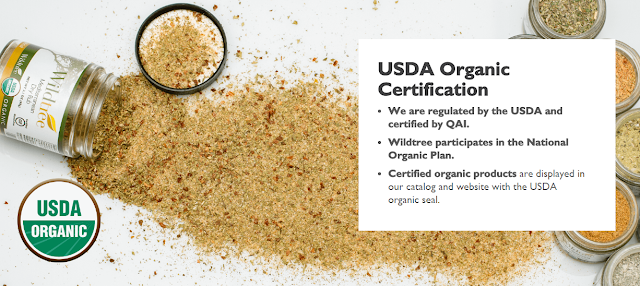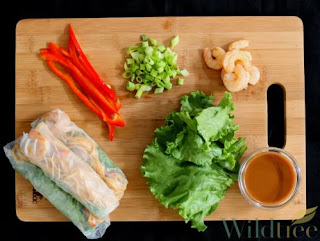Organic
is the new buzzword.
But
there are differences between Certified Organic, Organic and Natural that you
may be wondering about and should definitely know.
Everyone
seems to be talking about it, the mothers at the school canteen, your boss on
her "only green vegetables will enter my stratosphere" diet, and
maybe even your teenage daughter in an attempt to get rid of the pimples she
didn't invite along on her puberty journey.
But
like all buzzwords, there is a lot of misunderstanding around the word and some
nasty conundrums as well. Believe it or not, the idea of organic is really
quite simple, just like everything Mother Nature related. Basically, anything
confusing and wrong with it is probably caused by mortals, and maybe some
vampires... but that's another story.
If
keeping up with all the organic nuances is doing your head in, don't worry.
This guide should set you straight.
1.
There really is a difference...
Between
Certified Organic, Organic and Organic/Natural based products, that is. I don't
blame you for being a little iffy about this one because as someone immersed in
this field of expertise, you would think I'd have this one down pat by now.
Seriously,
I thought I did.
But
as I spoke to a potential distributor in Thailand last week, I realised that
maybe I only understood the difference in Australia. In all my naivety, I
actually (rather stupidly, it appears) believed that maybe there would be a
global definition for Organics. Silly me because that would make it, oh I don't
know, easy!
It
turns out that in Australia at least, Certified Organic refers to products that
are Organic and have been declared as such by an appropriate
government/independent body. Companies that are manufacturing Certified Organic
Products probably have CEOs that have lost all their hair by now. I'm not
kidding; I'd actually be prepared to put a wager on it which is saying
something considering my dismal betting record. Acquiring Organic Certification
is not a small feat, it takes loads of time, lots of documentation, going back
and forth a gazillion times and heaps of finance.
Organic
is probably (don't shoot me, I did say probably and even italicised it) exactly
the same in terms of quality and processing as Certified Organic without the
official badge of honour. What stops some people from purchasing organic
however is that there's no official proof. It's like swearing that you saw a
spaceship without the photograph to prove it. You may be wondering why I've
italicised official twice before. It's because the manufacturers of Organic
Products should have some sort of documentation stating that the products have
had no chemical and unnatural processing going on before it got to your
fingertips. Should doesn't always mean they do, which is wrong. Very wrong. At
least in my book anyway but we all have different yardsticks... you get the
picture.
Basically
organic products are based on trusting the manufacture within reason. Though
there's no official certification, the document stating the above still means
the manufacturer better be telling the truth or they're likely to be in hot
water if someone finds out otherwise.
Organic/Natural
Based is often referred to as Organic by Default.
What
this means is that an organic based product is likely to be exactly the way
Mother Nature intended. It's like growing your own tomatoes in your backyard
and then selling them at your kids' lemonade stand. They were grown exactly the
way the environment wanted them grown, the naturally perfect way and you don't
have to have any documentation stating so because well, Mother Nature didn't
pass one along, did she? Because if she did why are you here reading this post?
Go and tell someone now and get rich and famous.
2.
Should you even bother or is Organics nothing more than a buzzword for my much
richer neighbour?
Honestly,
I'm going to put my foot in it because it is one of my top three skills on my
resume.
Though
I am pretty much in charge (when my dad isn't watching) of a Certified
Organic/Organic/Organic based sustainable organisation located in a small
picturesque town that makes it hard not to be motivated to live as closely to
nature, the fact is that there is no comprehensive proof that organic is
actually better for you.
But...
because you know there's always a but, many people who swear by Organic
Products will never tire of telling you that you can't put a price on common
sense, or as my mum say's, common sense is not a commodity sold at the local
vegetable market. You have no idea how much using that saying pained me because
it was the quirky response I would often get when I came back home and told her
about something stupid I did (which till this day, continues to be often).
It
makes sense to use what Earth has created so bountifully for us seeing as we're
just one of the many creations of Mother Nature. It's interesting how every
continent has managed to come up with something useful naturally for its
inhabitants. India has Neem (The Tree of the 21st Century as declared by the
United Nations), Australia has Tea Tree Oil, the United States has Echinacea
while Europe has Geranium... you get it. Nature's made it so there's something
for everyone.
What
this signals to Organic enthusiasts is that the environment knows best. There's
a reason why certain plants and herbs are native to the areas that they are,
they're made up of stuff that your body needs because of where you live.
Ineloquent, I know, but you've got it down-pat.
What
does this mean for Natural Product lovers? They're willing to put their buck
where their mouth is and pay for what they believe is going to keep them and
their families healthy because it's only going to save them a lot of moolah and
heartache on hospital bills later on in life. Just saying.
3.
Okay, whatever. But why are Organic Products so much more expensive?
I
get it. They really are.
And
while it doesn't really cost you an arm and a leg to live organically (no some
of our customers, it really doesn't), they do cost more than their non-organic,
chemical filled substitutes.
People
can't often wrap their head around why this is exactly so I thought I'd give
you my two cents, naturally!
I
can't tell you how hard it is to acquire Certified Organic Products status
because this is a PG article and my keyboard is likely to break after I get
through all the swear words... from every language on the planet and Uranus.
Basically, it's as hard as um, nails.
As
you can imagine, it is difficult to ensure that your field of produce is
completely, 100% natural. This is because mostly, fields are often clumped
together and not all fields in an area are proclaiming to be organic. Which
means that pesticides used on one field can very understandably (due to weather
conditions such as wind changes and rain) land up on a "Certified
Organic" field.
Certified
Organic farmers are often extremely stressed obviously. Imagine having to
ensure that the weather listened to your whims and fancies. Don't believe me,
check out this (what some would refer to as ludicrous) news article. It is
becoming increasingly expensive for growers of natural produce (not to mention
difficult) to fulfil the requirements of organic certification which is proving
to be a massive burden on farmers who (for the most part) are trying in earnest
to do the right thing.
Sure,
organic produce is fast gaining popularity but the headaches surrounding the
promotion and growth around it makes certified organic farming more of a labour
of love than anything else. Organic farmers really do believe in the concept of
working with Mother Nature rather than against it. They believe in allowing the
Earth to take care of its produce the way it was always intended, with natural
resistances to pests and allowing foods to grow when they're supposed to.
Organic
farmers have to pass a little bit of the expense of growing their produce onto
the consumer to ensure that everyone is getting the best, most natural product
possible.
4.
Do I really need Organics?
Well,
do you really need those new pair of Louis Vuitton shoes or that Versace suit
you've had your eye on for the past six months. Chances are no. But that
doesn't change you wanting them, right?
It's
pretty much the same for Organic foods, except instead of evolving from our
slightly (dare I say) vain place, the need for organic foods is probably coming
from our gut and taste buds.
Your
body wants organic and naturally made and grown produce and though there is no
official proof that you need it, I would personally rather rely on my internal
organs knowing what's good for them than what some scientist (possibly financed
or aligned to some large multinational) is preaching to me.
Though
I am sceptical of my taste buds most of the time (particularly when they crave
hot fries and some sour cream and chives dip so they don't get lonely), when
they tell me a certain organically grown tomato should be on the menu tonight,
I listen a little more attentively (predominantly because they seem to be
behaving themselves - which is rare).
So,
to cut a long story (or in this case article) short, though I may not need
organics, I definitely want them. Just like my next pair of Louis Vuitton's so
hands off!
5.
Seasonal Foods are better for you?
Truly
Organic Foods are seasonal by their very definition. Because they're grown the
way nature intends, they grow when they're supposed to which often means that
your body is getting the nutrients it's meant to when it needs them the most.
They
also have less of an impact on the environment which has got to be a good
thing, right? Not only do consuming seasonal fruits ensure that local farmers
have more of a chance when battling against large multinationals and cheaper
prices from overseas, it also guarantees that the produce you consume is likely
to be fresher and therefore healthier.
Organic
produce that is also locally produced is the best option as it means that
you're helping to send your hard earned money back into your precious community
which will only serve to make everyone around you happier and more financially
stable, which has got to be a bonus, right? You're happy, you're neighbour's
happy, the dog's happy... you understand. I bet you're already feeling happier,
am I right?
Unfortunately
though, often local farmers can't afford to become certified organic, however
many local farmers may already be using organic methods (without the
certificate to prove it). Visit your local farmers market and speak to the
farmers selling their produce, you may just find that what they're doing is
already organic anyway. Want some more information on why everyone should be
bonkers about locally grown food? We hear you.
6.
There is an ongoing push for Organic Foods to be more Fairtrade
Organic
produce is not guaranteed to be Fairtrade, let me just put that out there
before you spam me with hate mail. I'm more of a lover, you see.
There
is a general consensus that Organic and Fairtrade should be amalgamated to
better serve the environment and community. After all, as harsh as it may
sound, people tend to be less concerned about their environment when the more
pressing matters of getting food on the table for their families is at the
forefront of their mind which is why there is such a push for organic produce
to also be Fairtrade, particularly in developing nations.
Let's
be completely honest here, it's not rocket science, is it? Everyone's
(regardless of culture or territories) number one priority is providing for
their families. Fairtrade practices ensure that farmers are able to sustain a
decent lifestyle which makes it easier and profitable for them to ensure that
the produce reaching your dining tables are as organic and natural as possible.
It's a win-win solution for everyone and considering how far and few in between
they are in general life, I say grab it with both hands when we can.
7.
Organic Foods last longer
Last
year I was so shocked to see how fresh my organically grown plums (from my
backyard) looked nearly four weeks after being picked. I guess I have my
gorgeous plum tree (I've nicknamed her Plumpilicious) to thank for piquing my
interest in the wonder of produce grown the way Mother Nature intended (not to
mention the scrumptious fruit my neighbours, workmates and I got as well from Plumpilicious's
beautiful bounty).
As
it turns out, organic produce really does last longer than their more
conventionally grown peers.
Which
makes you wonder, doesn't it? What do un-organic products have in them, that
even after all the preservatives and chemicals in them, they rot quicker? I
have absolutely no idea but articles like this one definitely shed more light
on the topic.
So,
in the end, I would suggest that it depends on the type of produce with regards
to whether organic or their non-organic counterparts last longer. Or it could
just be that Plumpilicious is one of a kind, I always had an inkling.
To
wrap this all up... Are you sold on Organics or not?
I
hope that this fairly comprehensive guide has helped clear some of the
misconceptions and confusion around the whole Organic concept for you. If
nothing more, I hope it's presented you with some good articles for you to sink
your teeth into around the fast becoming popular Organic space.
Many
of our customers are doubtful and unsure of what the purposes of Organic
products are and whether they're deserving of all the hype they're getting at
the moment. After working in an Organically geared organisation, I can't tell
you to go out and swap all your non-organic products with organic because that
would look suspicious. But, I would strongly urge you to try the concept out
after educating yourself on the whole shebang.
I
can present you with countless facts and figures (as well as case studies and
testimonials) on why you should go the Organic route but in the end, humans
like to try before they buy. It's this wonderful inquisitive mind we've all
been gifted (or cursed - whatever you prefer) with.
So
the only question that remains is, are you in or out? Let us know.
Nim-Véda
Australia is committed to manufacturing Organic Based Personal Care Products
(around Neem & Ayurveda) and High Quality Gourmet Organic Raw Food
Ingredients. We write extensively for a variety of reputable Organic and Health
oriented blogs (including Leaders in Heels, Natural Beauty Expert, Mouths of
Moms, and many more) and include tons of valuable information around the health
space at http://www.nimveda.com/blog. For more information on us, please visit
http://www.nimveda.com.
Article
Source: http://EzineArticles.com/expert/Mituri_Pradip_Sharma/2290969
Article
Source: http://EzineArticles.com/9436324





























